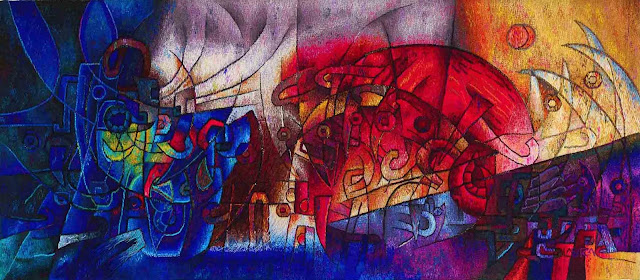 |
| Trees Seen Forest Remembered |
“Making art always puts me into a certain space, a meditation. I call this ‘being in the flow’. It allows thoughts and feelings to bubble up from the unconscious. I can put that energy into my art. Later, viewing the piece, I can revisit that feeling. It’s like reading a poem, or hearing a familiar story. It brings you back. It gives pleasure. That’s my hope for anyone viewing my pieces”....
Wen Redmond
New England resident Wen Redmond is a mixed media fiber artist who enjoys pushing boundaries to see "what if?". Redmond has worked in the fiber field since 1973, when she made her first intuitive textile construction. She graduated from Mansfield State, PA in 1972. Wen Redmond is a member of the League of New Hampshire Craftsmen since 1993. She is also a member of Professional Studio Art Quilt Association and their NH rep, Surface Design Association, Professional Fine Art Network, Women’s Caucus of Art, New Hampshire Art Association and Seacoast Fiber Artist Association. Her work can be seen nationwide, in galleries, juried, solo, and invitational shows as well as in numerous publications.
 |
| Being Moving on 2 |
Through the years Redmond built a steady reputation as an inovative textile artist. Stretching beyond that description, she’s making a mark with a new mix of medium, and a distinct look, using fabric, photos on cloth, stitching and found objects to create moody evocative works. Her multi-layered collages are assemblages of archival digital prints, combining painting and digital media into a one of a kind art piece. Multi-layered surface design creates Holographic Images. The work is layered with a duplicate photograph underneath so the viewer sees a 3-D effect. This is an innovative photography design technique that needs to be seen to be appreciated. Her fascination with photography is finding expression by printing directly onto various substrates, creating stitched textural constructions. Wen calls this work Digital Fiber. All the fabrics she uses, are created by her. She creates the entire structure of her one of a kind art pieces. Each work is unique and created individually.
Wen Redmond's creative warren is an inspiration in itself. Along a bank of windows that overlook the rocky falls, a cluster of crystals line one windowsill, sea shells another. To make her dreamy scenes, Redmond drapes transparent fabric over photos of rocks and trees. "Making art is all about inner reality," she said. "You put into it what you have inside.
Wen’s work is innovative and fresh, not in any one niche. Her work overlaps media and surface design. She designs one of a kind art pieces, developing transparent effects and layers begging closer inspection. Wen delights in creating dialogue, changing your perspectives and perceptions of fiber.
 |
| Whispers of the Positive |
She is passionate about coming up with ideas and working out the kinks. This leads to more discoveries, an evolution. The artist in her can see the most exquisite scenes or combinations of patterns and wants to share that beauty. Her art represents these moments. They are what lie beneath. She brings them back to share, to remind, to remember. These moments become her source, her well. Wen Redmond hopes to bring that energy into her art making, to communicate the positive. Layers peeled back reveal the source, the inspiration, and her mad desire to capture thoughts, dreams and the beauty of nature. Each work is individual and a communication between Wen’s inner imagination and later, the viewer.
 |
| Bird in Arms |
Redmond has worked with fabrics her entire life, graduating from college with an excellent working knowledge. She creates all of her unique textiles, with additional training from some of the country’s most innovative fiber artists. Wen continues to explore her chosen medium, fabric, to see what it can do, to stretch its perception as art medium.
The one certain thing about Wen Redmond is that she is always inventing new ways of expressing her artistic intent. Wen describes her artwork on her website as an unusual use of fiber combining painting and digital media. Her innovation was rewarded this year by selection for Quilt National as well as being featured in several magazines. Her artwork is shown throughout the U.S. in galleries and special exhibits. Wen shares her discoveries and techniques in workshops at her New Hampshire studio as well as at conferences and exhibitions. You can visit Wen’s studio and see what inspires her on her website and her lively blog.
 |
| Shaking the Tree of Imagination Pause |
 |
| Three Feathers |
 |
| Crossroads Cormorants Perch |
 |
| Poles to Trees |
 |
| Perception of Trees |










































